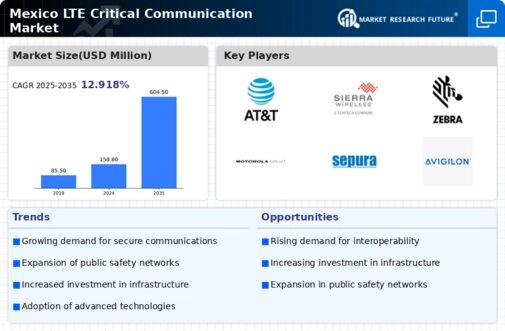Expansion of Private Sector Participation
The involvement of private sector entities in the lte critical-communication market is becoming increasingly prominent in Mexico. As public agencies seek to enhance their communication capabilities, partnerships with private companies are facilitating the development of innovative solutions. In 2025, it is anticipated that private sector investments in critical communication technologies will exceed $300 million, driven by the demand for customized solutions that meet specific operational needs. This collaboration is likely to lead to the emergence of new business models and service offerings within the lte critical-communication market, fostering a competitive landscape that encourages innovation and efficiency. The synergy between public and private sectors is expected to enhance the overall effectiveness of critical communication systems across the country.
Growing Demand for Reliable Communication
The increasing need for dependable communication systems in critical sectors such as public safety, emergency services, and transportation is driving the lte critical-communication market in Mexico. As urbanization accelerates, the demand for robust communication networks that can withstand emergencies and ensure seamless connectivity is paramount. In 2025, the Mexican government allocated approximately $500 million to enhance communication infrastructure, reflecting a commitment to improving public safety. This investment is expected to bolster the capabilities of first responders and emergency services, thereby enhancing overall operational efficiency. The lte critical-communication market is likely to benefit from this trend, as organizations seek to implement advanced communication solutions that can facilitate real-time data sharing and coordination during crises.
Increased Focus on Cybersecurity Measures
As the reliance on digital communication systems grows, so does the emphasis on cybersecurity within the lte critical-communication market. In Mexico, the government has initiated several programs aimed at enhancing the security of communication networks, particularly those used by emergency services. In 2025, investments in cybersecurity measures are expected to reach $200 million, reflecting a proactive approach to safeguarding critical communication infrastructure. This focus on cybersecurity is likely to drive the adoption of advanced encryption and authentication technologies, ensuring that sensitive information remains protected during emergencies. The lte critical-communication market will benefit from this heightened awareness, as organizations seek to implement secure communication solutions that can withstand potential cyber threats.
Integration of IoT in Critical Communication
The integration of Internet of Things (IoT) technologies into critical communication systems is emerging as a significant driver for the lte critical-communication market in Mexico. IoT devices enable real-time monitoring and data collection, which enhances situational awareness for emergency responders. In 2025, the market for IoT-enabled communication solutions is projected to grow by 25%, as organizations recognize the value of interconnected devices in improving response times and operational efficiency. This trend is likely to lead to the development of more sophisticated communication networks that can support a wide range of applications, from smart city initiatives to disaster management. The lte critical-communication market is poised to capitalize on this integration, as it aligns with the growing demand for innovative and efficient communication solutions.
Regulatory Support for Enhanced Communication Standards
Regulatory frameworks in Mexico are increasingly supportive of advanced communication standards, which is a key driver for the lte critical-communication market. The government has established guidelines that promote the adoption of LTE technology in critical communication applications. This regulatory environment encourages public and private sector collaboration, leading to the development of innovative solutions tailored to meet the specific needs of emergency services. In 2025, it is estimated that compliance with these standards could lead to a 30% increase in the deployment of LTE-based communication systems across various sectors. The lte critical-communication market stands to gain from this supportive regulatory landscape, as it fosters an ecosystem conducive to technological advancements and improved service delivery.























Leave a Comment